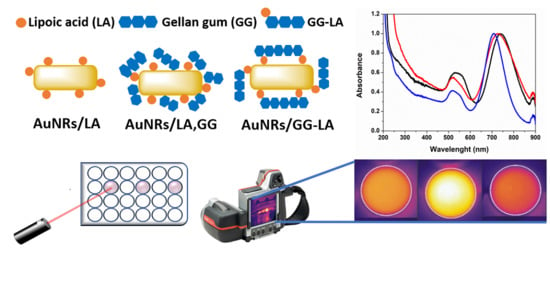Preparation and Characterization of Gold Nanorods Coated with Gellan Gum and Lipoic Acid
Abstract
:1. Introduction
2. Materials and Methods
2.1. Materials
2.2. Synthesis and Characterization of the Gellan Gum Derivative GG-LA
2.3. Synthesis and Scanning Electron Microscopy (SEM) of CTAB-Stabilized AuNRs (CTAB-AuNRs)
2.4. Preparation of Coated AuNRs (AuNRs/LA, AuNRs/LA,GG, and AuNRs/GG-LA)
2.5. UV–VIS–NIR Spectroscopy, Stability Studies, and Reconstitution Tests
2.6. Dynamic Light Scattering Analyses, Zeta Potential Measurements, and Determination of Gold Content
2.7. Synthesis of LA-TRH Derivative and LA Determination Content in AuNRs/LA-TRH Systems
2.8. X-ray Photoelectron Spectroscopy (XPS) Analyses on AuNRs/LA
2.9. Evaluation of Coated Gold Nanorods Hyperthermia
2.10. Cytocompatibility Tests
2.11. In Vitro Evaluation of the Hyperthermal Effect on HCT116 Cell Line
2.12. Statistical Analysis
3. Results and Discussion
3.1. Synthesis of GG-LA Derivative
3.2. Preparation and Characterization of Coated AuNRs
3.3. In Vitro Studies
4. Conclusions
Author Contributions
Funding
Acknowledgments
Conflicts of Interest
References
- McNamara, K.; Tofail, S.A.M. Nanoparticles in biomedical applications. Adv. Phys. X 2017, 2, 54–88. [Google Scholar] [CrossRef]
- Licciardi, M.; Scialabba, C.; Puleio, R.; Cassata, G.; Cicero, L.; Cavallaro, G.; Giammona, G. Smart copolymer coated SPIONs for colon cancer chemotherapy. Int. J. Pharm. 2019, 556, 57–67. [Google Scholar] [CrossRef] [PubMed]
- Licciardi, M.; Li Volsi, A.; Mauro, N.; Scialabba, C.; Cavallaro, G.; Giammona, G. Preparation and characterization of inulin coated gold nanoparticles for selective delivery of doxorubicin to breast cancer cells. J. Nanomater. 2016, 19, 1–12. [Google Scholar] [CrossRef] [Green Version]
- El-Sayed, I.H.; Huang, X.; El-Sayed, M.A. Selective laser photo-thermal therapy of epithelial carcinoma using anti-EGFR antibody conjugated gold nanoparticles. Cancer Lett. 2006, 239, 129–135. [Google Scholar] [CrossRef]
- Chaturvedi, V.K.; Singh, A.; Singh, V.K.; Singh, M.P. Cancer Nanotechnology: A New Revolution for Cancer Diagnosis and Therapy. Curr. Drug Metab. 2018, 20, 416–429. [Google Scholar] [CrossRef]
- Scialabba, C.; Puleio, R.; Peddis, D.; Varvaro, G.; Calandra, P.; Cassata, G.; Cicero, L.; Licciardi, M.; Giammona, G. Folate targeted coated SPIONs as efficient tool for MRI. Nano Res. 2017, 10, 3212–3227. [Google Scholar] [CrossRef]
- Mauro, N.; Scialabba, C.; Puleio, R.; Varvarà, P.; Licciardi, M.; Cavallaro, G.; Giammona, G. SPIONs embedded in polyamino acid nanogels to synergistically treat tumor microenvironment and breast cancer cells. Int. J. Pharm. 2019, 555, 207–219. [Google Scholar] [CrossRef]
- Mauro, N.; Drago, S.E.; Cavallaro, G.; Giammona, G. Near-Infrared, Light-Triggered, On-Demand Anti-inflammatories and Antibiotics Release by Graphene Oxide/Elecrospun PCL Patch for Wound Healing. C J. Carbon Res. 2019, 5, 63. [Google Scholar] [CrossRef] [Green Version]
- Sun, X.; Liu, Z.; Welsher, K.; Robinson, J.T.; Goodwin, A.; Zaric, S.; Dai, H. Nano-graphene oxide for cellular imaging and drug delivery. Nano Res. 2008, 1, 203–212. [Google Scholar] [CrossRef] [Green Version]
- Hirsch, L.R.; Stafford, R.J.; Bankson, J.A.; Sershen, S.R.; Rivera, B.; Price, R.E.; Hazle, J.D.; Halas, N.J.; West, J.L. Nanoshell-mediated near-infrared thermal therapy of tumors under magnetic resonance guidance. Proc. Natl. Acad. Sci. USA 2003, 100, 13549–13554. [Google Scholar] [CrossRef] [Green Version]
- Slowing, I.I.; Vivero-Escoto, J.L.; Wu, C.W.; Lin, V.S.Y. Mesoporous silica nanoparticles as controlled release drug delivery and gene transfection carriers. Adv. Drug Deliv. Rev. 2008, 60, 1278–1288. [Google Scholar] [CrossRef]
- Åkerman, M.E.; Chan, W.C.W.; Laakkonen, P.; Bhatia, S.N.; Ruoslahti, E. Nanocrystal targeting in vivo. Proc. Natl. Acad. Sci. USA 2002, 99, 12617–12621. [Google Scholar] [CrossRef] [PubMed] [Green Version]
- Li Volsi, A.; Fiorica, C.; D’Amico, M.; Scialabba, C.; Palumbo, F.S.; Giammona, G.; Licciardi, M. Hybrid Gold/Silica/Quantum-Dots supramolecular-nanostructures encapsulated in polymeric micelles as potential theranostic tool for targeted cancer therapy. Eur. Polym. J. 2018, 105, 38–47. [Google Scholar] [CrossRef]
- Li Volsi, A.; de Jimenez Aberasturi, D.; Henriksen-Lacey, M.; Giammona, G.; Licciardi, M.; Liz-Marzán, L.M.; Webb, J.A.; Bardhan, R.; van der Meel, R.; Vehmeijer, L.J.C.; et al. Inulin coated plasmonic gold nanoparticles as a tumor-selective tool for cancer therapy. J. Mater. Chem. B 2016, 4, 1150–1155. [Google Scholar] [CrossRef] [PubMed] [Green Version]
- Puleio, R.; Licciardi, M.; Varvarà, P.; Scialabba, C.; Cassata, G.; Cicero, L.; Cavallaro, G.; Giammona, G. Effect of actively targeted copolymer coating on solid tumors eradication by gold nanorods-induced hyperthermia. Int. J. Pharm. 2020, 587, 119641. [Google Scholar] [CrossRef] [PubMed]
- Li, N.; Zhao, P.; Astruc, D. Anisotropic gold nanoparticles: Synthesis, properties, applications, and toxicity. Angew. Chemie Int. Ed. 2014, 53, 1756–1789. [Google Scholar] [CrossRef]
- Scarabelli, L.; Grzelczak, M.; Liz-Marzán, L.M. Tuning Gold Nanorod Synthesis through Prereduction with Salicylic Acid. Chem. Mater. 2013, 25, 4232–4238. [Google Scholar] [CrossRef] [Green Version]
- Grzelczak, M.; Pérez-Juste, J.; Mulvaney, P.; Liz-Marzán, L.M. Shape control in gold nanoparticle synthesis. Chem. Soc. Rev. 2008, 37, 1783–1791. [Google Scholar] [CrossRef]
- Huang, X.; El-Sayed, M.A. Gold nanoparticles: Optical properties and implementations in cancer diagnosis and photothermal therapy. J. Adv. Res. 2010, 1, 13–28. [Google Scholar] [CrossRef] [Green Version]
- Jain, P.K.; Huang, X.; El-Sayed, I.H.; El-Sayed, M.A. Noble Metals on the Nanoscale: Optical and Photothermal Properties and Some Applications in Imaging, Sensing, Biology, and Medicine. Acc. Chem. Res. 2008, 41, 1578–1586. [Google Scholar] [CrossRef]
- Chanana, M.; Liz-Marzán, L.M. Coating matters: The influence of coating materials on the optical properties of gold nanoparticles. Nanophotonics 2012, 1, 199–220. [Google Scholar] [CrossRef]
- Packer, L.; Witt, E.H.; Tritschler, H.J. Alpha-lipoic acid as a biological antioxidant. Free Radic. Biol. Med. 1995, 19, 227–250. [Google Scholar] [CrossRef]
- Biewenga, G.P.; Haenen, G.R.M.M.; Bast, A. The pharmacology of the antioxidant: Lipoic acid. Gen. Pharmacol. 1997, 29, 315–331. [Google Scholar] [CrossRef]
- Brown, M.K.; Evans, J.L.; Luo, Y. Beneficial effects of natural antioxidants EGCG and α-lipoic acid on life span and age-dependent behavioral declines in Caenorhabditis elegans. Pharmacol. Biochem. Behav. 2006, 85, 620–628. [Google Scholar] [CrossRef]
- Gobin, A.M.; Watkins, E.M.; Quevedo, E.; Colvin, V.L.; West, J.L. Near-Infrared-Resonant Gold/Gold Sulfide Nanoparticles as a Photothermal Cancer Therapeutic Agent. Small 2010, 6, 745–752. [Google Scholar] [CrossRef] [Green Version]
- Pensa, E.; Cortés, E.; Corthey, G.; Carro, P.; Vericat, C.; Fonticelli, M.H.; Benítez, G.; Rubert, A.A.; Salvarezza, R.C. The chemistry of the sulfur-gold interface: In search of a unified model. Acc. Chem. Res. 2012, 45, 1183–1192. [Google Scholar] [CrossRef]
- Du, X.; Lin, W.C.; Shou, Q.; Liang, X.; Liu, H. pH optimization for high-efficiency PEGylation of gold nanorods. Colloid Polym. Sci. 2019, 297, 891–902. [Google Scholar] [CrossRef]
- Zhang, L.; Xia, K.; Bai, Y.Y.; Lu, Z.; Tang, Y.; Deng, Y.; Chen, J.; Qian, W.; Shen, H.; Zhang, Z.; et al. Synthesis of gold nanorods and their functionalization with bovine serum albumin for optical hyperthermia. J. Biomed. Nanotechnol. 2014, 10, 1440–1449. [Google Scholar] [CrossRef]
- Palumbo, F.S.; Federico, S.; Pitarresi, G.; Fiorica, C.; Giammona, G. Gellan gum-based delivery systems of therapeutic agents and cells. Carbohydr. Polym. 2020, 229, 115430. [Google Scholar] [CrossRef]
- FDA. Food Additives Permitted For Direct Addition To Food For Human Consumption; 21 CFR 172.665; FDA: Silver Spring, MD, USA, 2019.
- Dhar, S.; Maheswara Reddy, E.; Shiras, A.; Pokharkar, V.; Prasad, B.L.V. Natural gum reduced/stabilized gold nanoparticles for drug delivery formulations. Chem. A Eur. J. 2008, 14, 10244–10250. [Google Scholar] [CrossRef]
- Agnello, S.; Palumbo, F.S.; Pitarresi, G.; Fiorica, C.; Giammona, G. Synthesis and evaluation of thermo-rheological behaviour and ionotropic crosslinking of new gellan gum-alkyl derivatives. Carbohydr. Polym. 2018, 185, 73–84. [Google Scholar] [CrossRef] [PubMed]
- Hendel, T.; Wuithschick, M.; Kettemann, F.; Birnbaum, A.; Rademann, K.; Polte, J. In Situ Determination of Colloidal Gold Concentrations with UV–Vis Spectroscopy: Limitations and Perspectives. Anal. Chem. 2014, 86, 11115–11124. [Google Scholar] [CrossRef] [PubMed]
- Picone, C.S.F.; Cunha, R.L. Influence of pH on formation and properties of gellan gels. Carbohydr. Polym. 2011, 84, 662–668. [Google Scholar] [CrossRef] [Green Version]
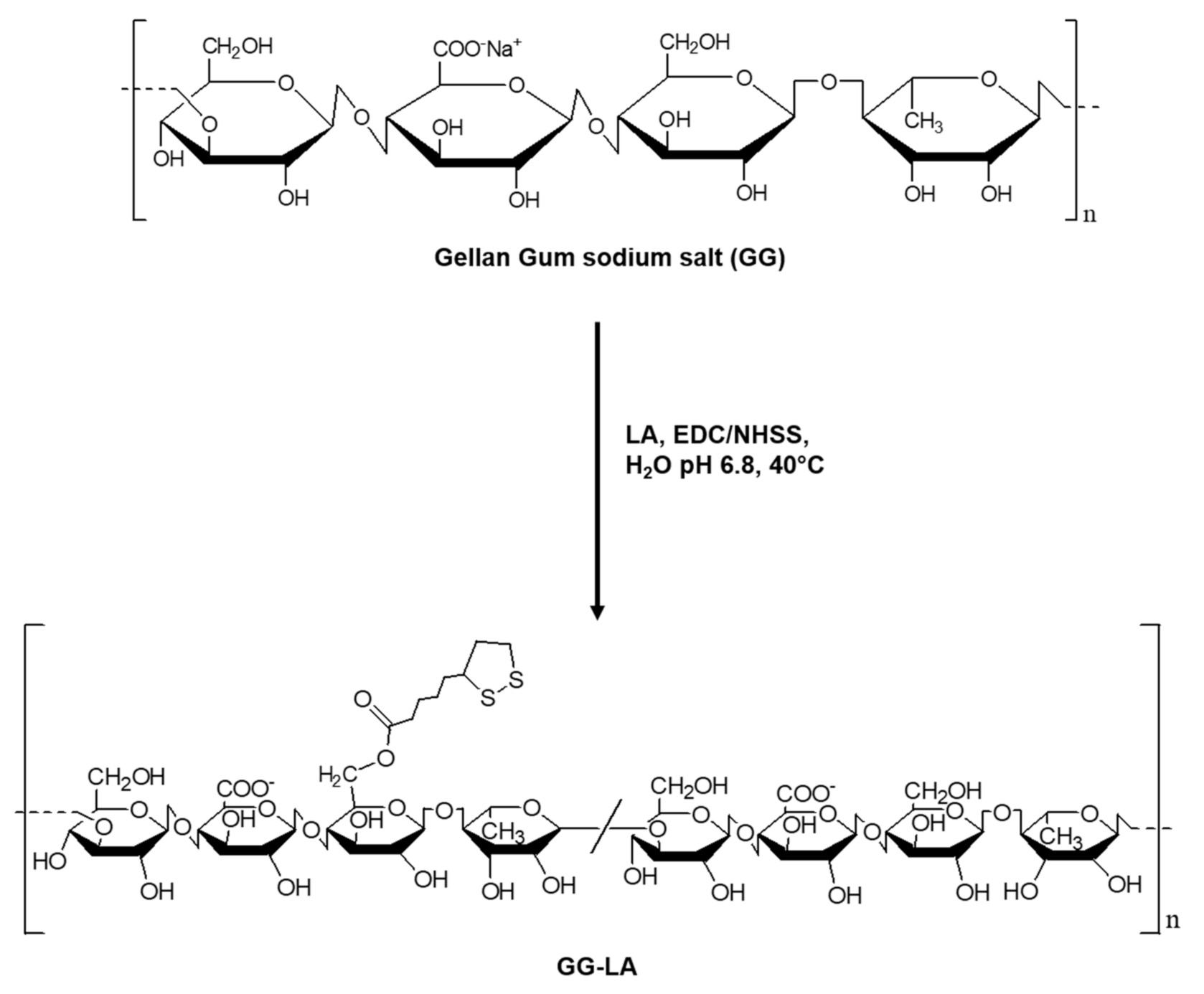
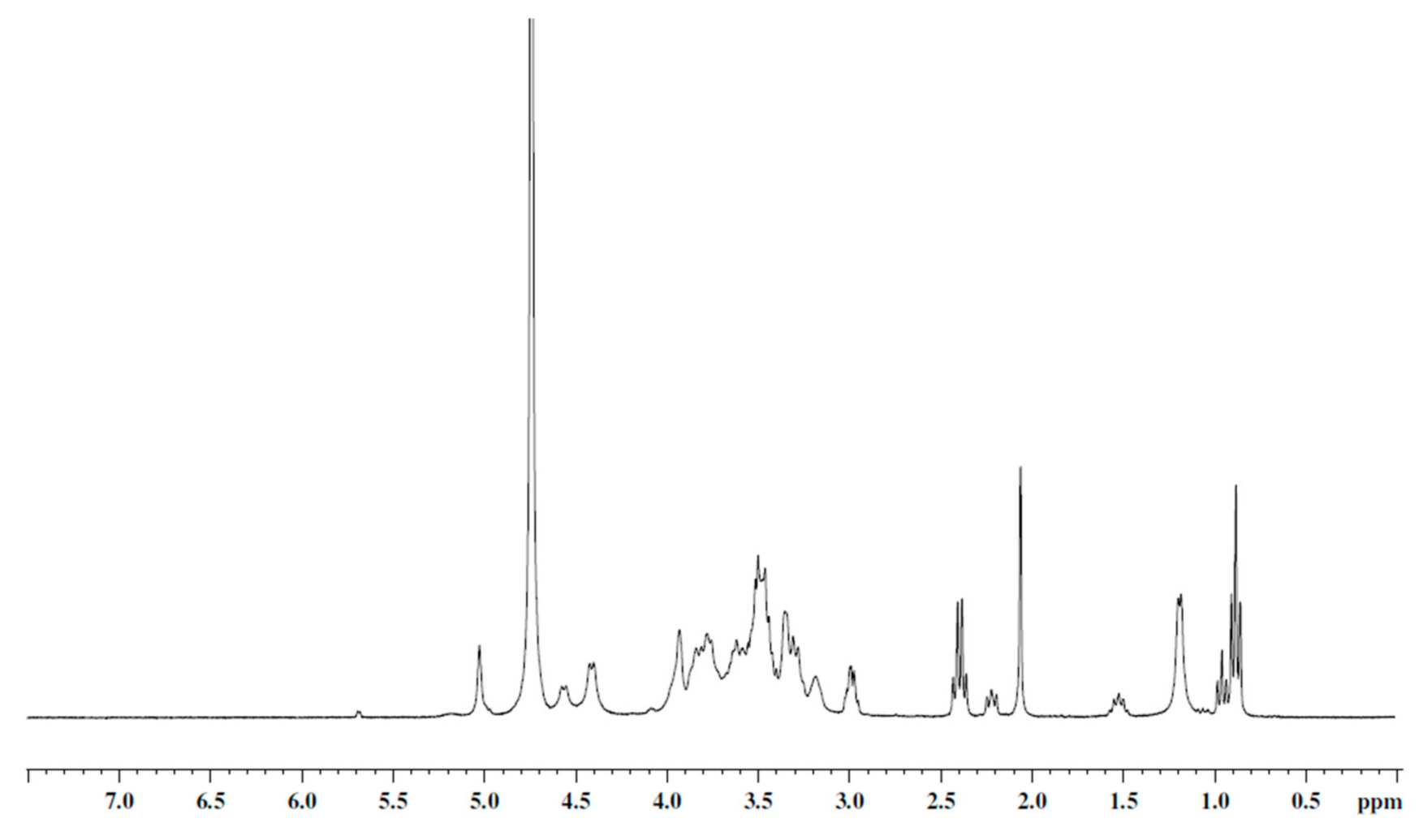
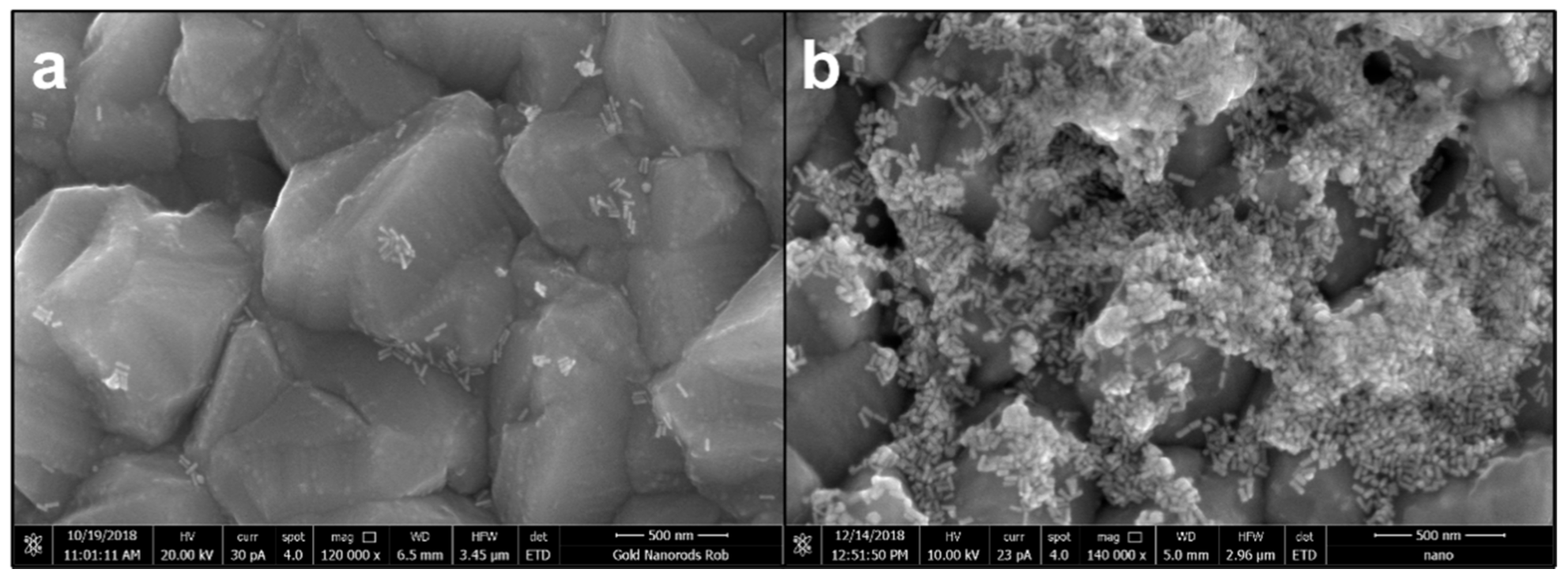
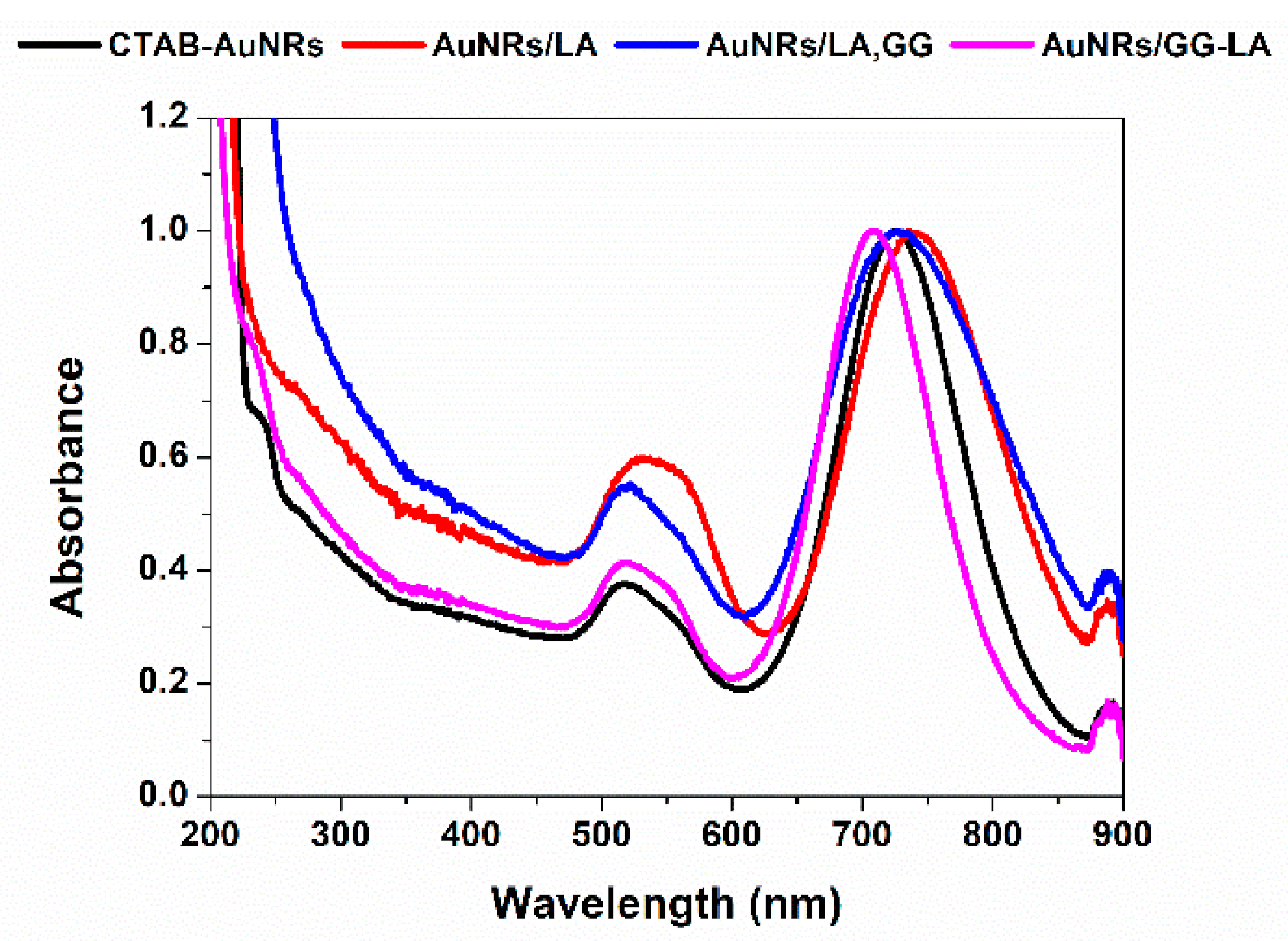
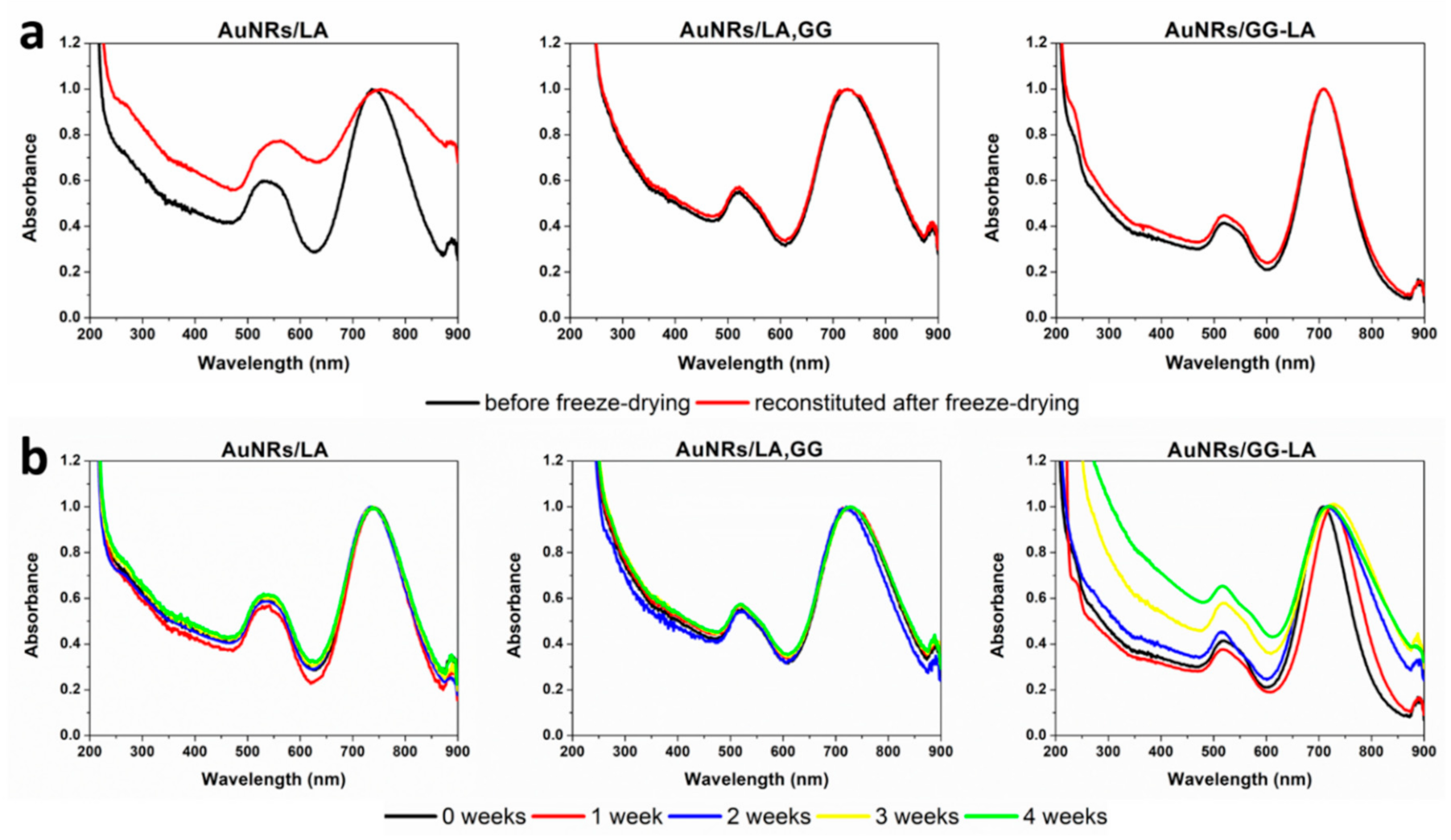
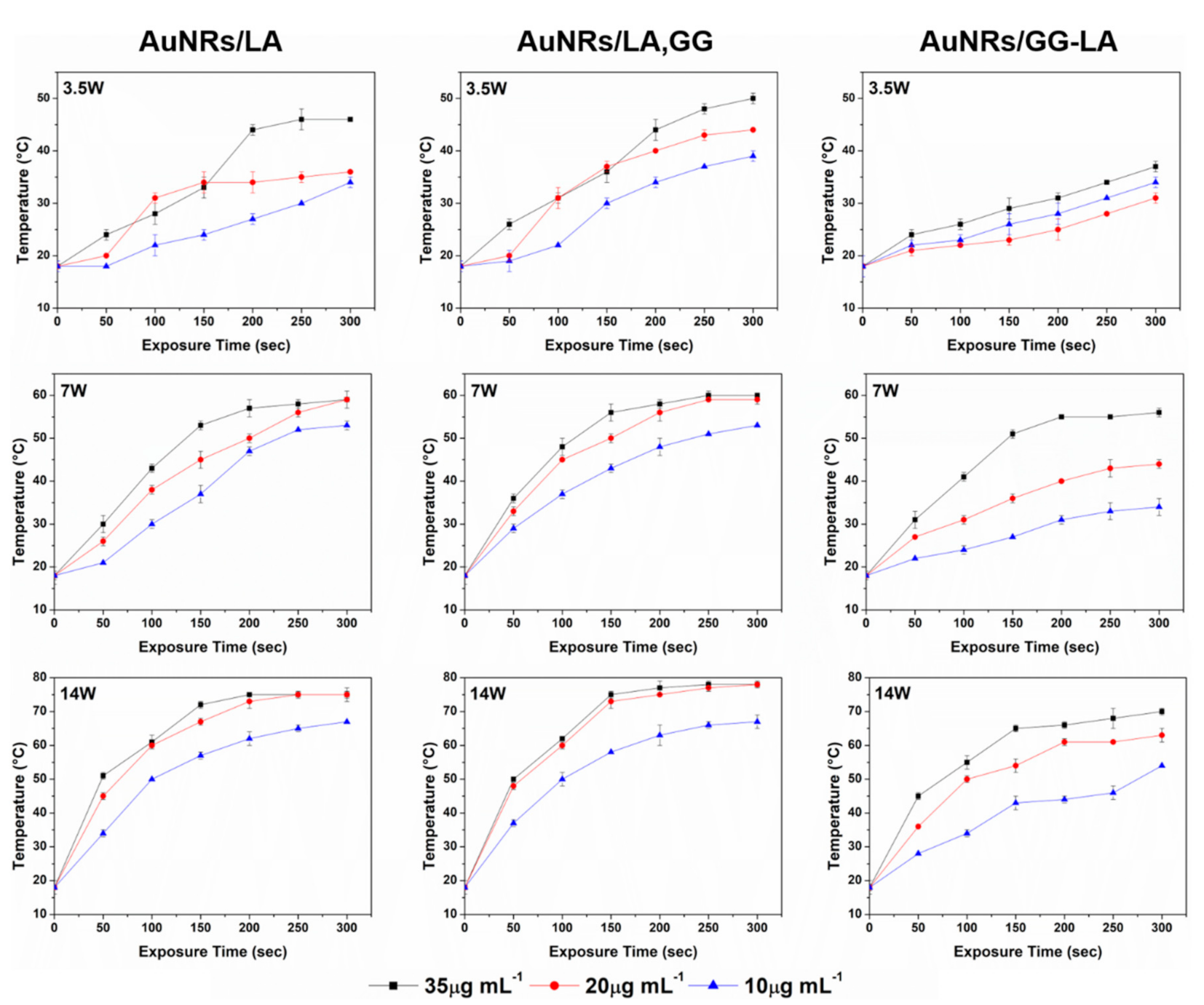

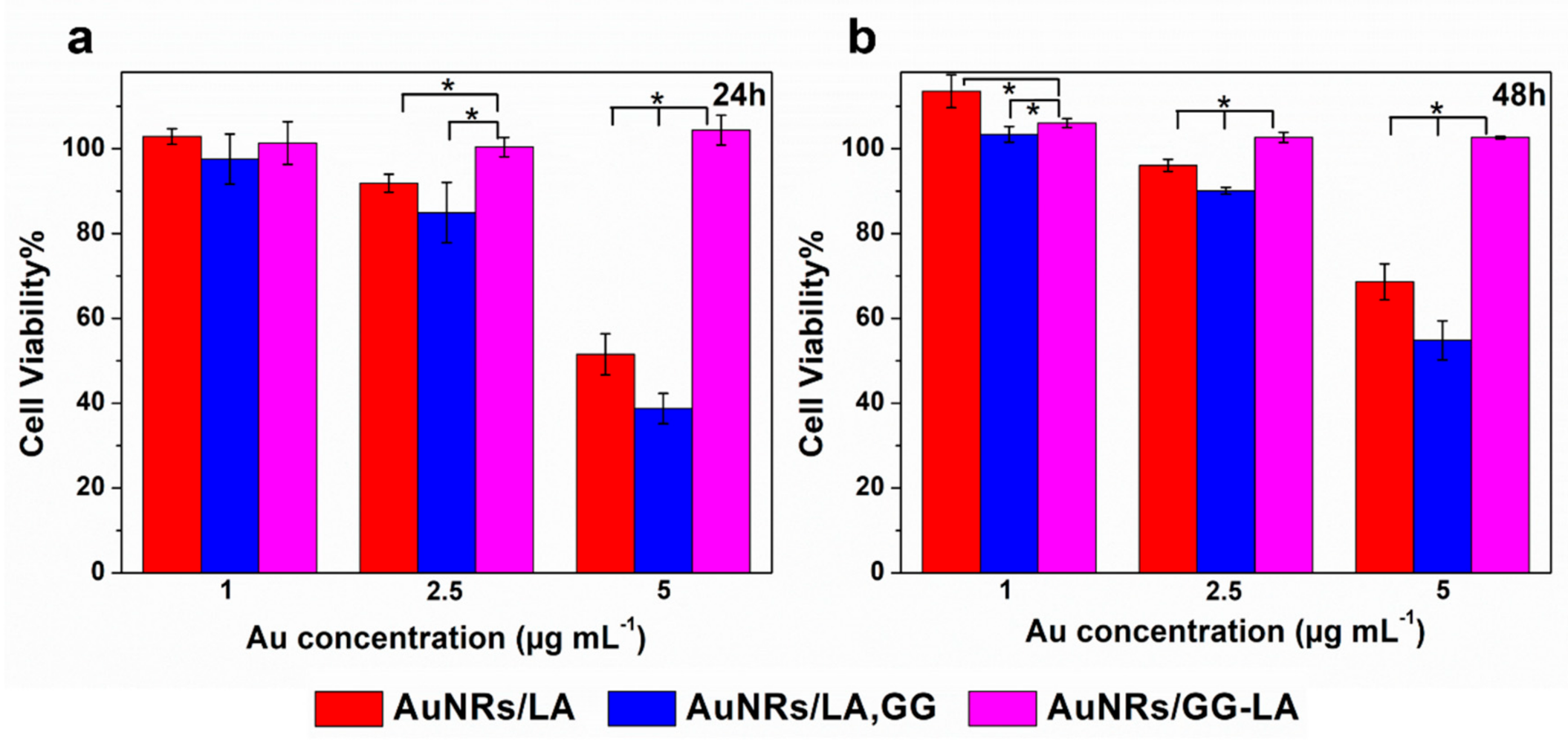
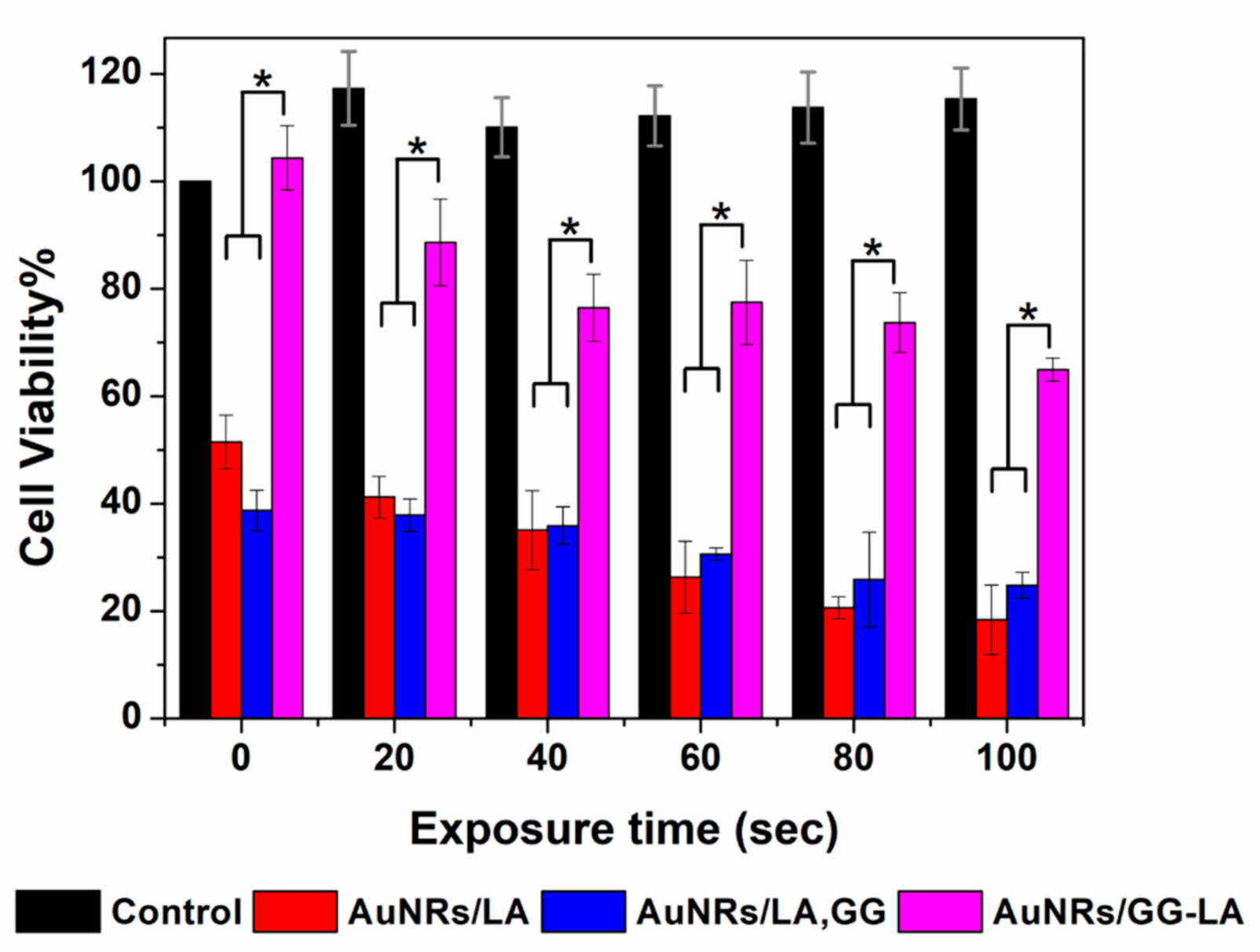

| Sample | Mw (Da) | Mn (Da) | PDI |
|---|---|---|---|
| GG sodium salt | 43,600 | 31,500 | 1.38 |
| GG-LA | 70,600 | 54,412 | 1.30 |
| Atom | % |
|---|---|
| Au | 11.45 |
| S | 0.97 |
| C | 72.39 |
| O | 15.19 |
| Sample | Size (nm) | PDI | Zeta Potential (mV) |
|---|---|---|---|
| CTAB-AuNRs | 61.1 ± 26 | 0.55 | +41 ± 12.1 |
| AuNRs/LA | 97.5 ± 34 | 0.64 | +19.5 ± 6.76 |
| AuNRs/LA,GG | 146.7 ± 12 | 0.50 | −17.1 ± 4.96 |
| AuNRs/GG-LA | 173.0 ± 18 | 0.47 | −25.6 ± 5.77 |
| Sample | Temperature (°C) versus Exposure Time (Seconds) | |||||
|---|---|---|---|---|---|---|
| 0 s | 20 s | 40 s | 60 s | 80 s | 100 s | |
| AuNRs/LA,GG 2.5 mg·mL−1 Au | 25 °C | 33 °C | 36.9 °C | 40.3 °C | 43.4 °C | 46.4 °C |
| AuNRs/LA,GG 5 mg·mL−1 Au | 25 °C | 37.7 °C | 42.6 °C | 47.1 °C | 51 °C | 54.5 °C |
| AuNRs/LA 2.5 mg·mL−1 Au | 25 °C | 30.3 °C | 32.5 °C | 24.5 °C | 36.2 °C | 37.6 °C |
| AuNRs/LA 5 mg·mL−1 Au | 25 °C | 34.5 °C | 38 °C | 41.2 °C | 43.9 °C | 45.6 °C |
| AuNRs/GG-LA 2.5 mg·mL−1 Au | 25 °C | 29.9 °C | 31.6 °C | 32.9 °C | 34.4 °C | 35.6 °C |
| AuNRs/GG-LA 5 mg·mL−1 Au | 25 °C | 31.5 °C | 34.3 °C | 37.1 °C | 39.3 °C | 41.5 °C |
| Blank (water) | 25 °C | 26 °C | 26 °C | 27.1 °C | 28.7 °C | 29.8 °C |
Publisher’s Note: MDPI stays neutral with regard to jurisdictional claims in published maps and institutional affiliations. |
© 2020 by the authors. Licensee MDPI, Basel, Switzerland. This article is an open access article distributed under the terms and conditions of the Creative Commons Attribution (CC BY) license (http://creativecommons.org/licenses/by/4.0/).
Share and Cite
Varvarà, P.; Tranchina, L.; Cavallaro, G.; Licciardi, M. Preparation and Characterization of Gold Nanorods Coated with Gellan Gum and Lipoic Acid. Appl. Sci. 2020, 10, 8322. https://doi.org/10.3390/app10238322
Varvarà P, Tranchina L, Cavallaro G, Licciardi M. Preparation and Characterization of Gold Nanorods Coated with Gellan Gum and Lipoic Acid. Applied Sciences. 2020; 10(23):8322. https://doi.org/10.3390/app10238322
Chicago/Turabian StyleVarvarà, Paola, Luigi Tranchina, Gennara Cavallaro, and Mariano Licciardi. 2020. "Preparation and Characterization of Gold Nanorods Coated with Gellan Gum and Lipoic Acid" Applied Sciences 10, no. 23: 8322. https://doi.org/10.3390/app10238322
APA StyleVarvarà, P., Tranchina, L., Cavallaro, G., & Licciardi, M. (2020). Preparation and Characterization of Gold Nanorods Coated with Gellan Gum and Lipoic Acid. Applied Sciences, 10(23), 8322. https://doi.org/10.3390/app10238322





